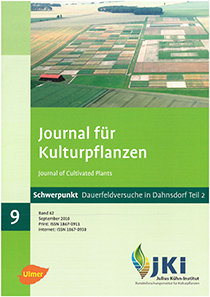Review of the field experiments in Dahnsdorf (German state Brandenburg) aiming at evaluation of genetically modified crops for the goals of integrated plant protection and for coexistence
DOI:
https://doi.org/10.5073/JfK.2010.09.04Keywords:
Oilseed rape, maize, potato, genetically modified crops, GMO, plant protection, performance, glufosinate, herbicide resistance, fructan, integrated plant protectionAbstract
Worldwide cultivation of genetically modified crops has reached more than 130 million ha in 2009. In Germany, where the cultivation has been stopped since 2008, the risks and benefits of these cultivars are intensely discussed. From the beginning the Julius Kühn-Institut (JKI) has contributed objectively with scientific investigations and statements to the context of this discussion. From 1996 to 2009, field experiments with genetically modified winter oilseed rape, maize and potatoes and experiments on the coexistence of maize were conducted at the experimental field station of the JKI in Dahnsdorf, German state Brandenburg. The traits used were herbicide resistance to glufosinate in oilseed rape and maize, and fructan synthesizing in potatoes. In comparison with the conventionally bred counterparts the genetically modified cultivars and lines met all relevant biosafety requirements. Out-crossing of transgenic oilseed rape and maize into conventional cultivars were observed, but can be kept low by isolation distances or agronomic measures during harvest. The distinct observed agronomic advantages and disadvantages of glufosinate resistant crops have to be considered cautiously in order to design sustainably integrated plant protection and soil management systems. The genetic modification of the fructan potato led unexpectedly to further changes such as the length of the main shoot and susceptibility for pests and diseases. However, these side effects are not expected to cause higher intensities in plant protection or increased risks for the environment. The review summarizes main results of the long term experiments in Dahnsdorf, and considers new results of growing genetically modified crops and biosafety research.
Downloads
Published
Issue
Section
License
The content of the journal is licensed under the Creative Commons Attribution 4.0 License. Any user is free to share and adapt (remix, transform, build upon) the content as long as the original publication is attributed (authors, title, year, journal, issue, pages).
The copyright of the published work remains with the authors. The authors grant the Journal of Cultivated Plants, the Julius Kühn-Institut and the OpenAgrar repository the non-exclusive right to distribute and exploit the work.







